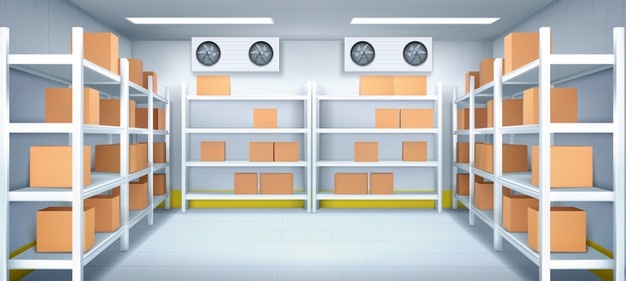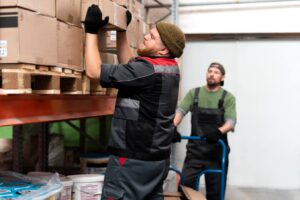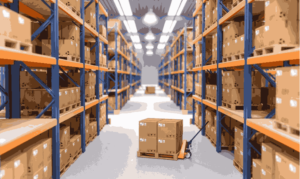Cold storage is the storage of any temperature-controlled substance that prevents the substance from decaying or not adhering to the basic regulations that apply to that item.
Cold storage warehouse management is a highly specialized skill that requires comprehensive knowledge of the industry, the ability to monitor processes closely occurring both inside and outside the facility, and constantly staying up to date on new and evolving state-of-the-art technological solutions available.
Effective management of a cold storage warehouse is no small joke, however, it requires close attention to detail and management techniques to ensure optimum productivity is maintained, despite the harsh & freezing conditions. As demand for perishable products grows across the world, efficient and effective cold chain management requires strong partnerships and quick turnaround time.
Distribution centers across the regions share many of the same challenges, whether it be space optimization, picking methods or the integration of automated systems. However, managers of cold storage facilities find themselves in the peculiar situation of not only being responsible for maintaining the quality and safety of their sensitive stock, but also the safety and well-being of their workers under these typical environmental circumstances.
Refrigerated and frozen foods account for the majority of products stored in cold storage warehouses. Cold storage is also vital for other industries as well such as pharmaceuticals, petrochemicals and even high-tech electronics.
Challenges in Cold Storage Warehouse Management
-
Food protection
Regulating and maintaining the right temperature and humidity to maintain and extend the life of your products can be challenging as well as risky, as different products require different temperatures to be sustained. Traditional temperature monitoring systems depend solely on the experience of the operator who must be on-site to adjust and manage the whole system.
-
Maintaining product’s lifecycle
Correctly maintaining the temperature of perishable products is necessary to preserve its quality and safety from the start point of production through the supply chain to the consumer. Failing to maintain proper shipment leads to textual degradation, discoloring, damaging and infective growth of food products.
-
Labelling product and racks
Barcode labels create the essential link between physical products and the computer systems that monitor receiving, storage, retrieval and shipments. Appropriate freeze-grade rack labels serve as a critical factor in the entire traceability system. Freezer-grade rack labels develop a strong permanent bond on common rack surfaces, and can be applied in environments as low as -20°F.
-
Product traceability
In the case of temperature excursions, finding out and determining the affected product is only possible with accurate location information. Products like fresh produce require additional control over factors such as carbon dioxide and humidity. Very Specific and accurate documentation is mandatory.
-
Fulfillment and courier shipments
The entire cold chain process should be about minimizing the time it takes to move a product through the system. Chances of vulnerabilities are higher if there are delays in handing products off from one facility to another.
- The average shipment—both inbound from supplier to distribution center, and outbound to customers—is made up of less-than-truckload amounts of food products.
- All products must be loaded correctly to prevent any cross-contamination with the raw product and damage with the heavier items placed at the bottom.
Perishable foods, particularly seafood, pre-cut produce and ready-to-eat products, can become unsafe if not kept at the appropriate temperatures.
Best Practices for Cold Storage Warehouse Management
-
Conquering the alternating temperature ranges
In cold storages, energy savings is a recurring concern. It’s a fact that it is far more expensive to cool the air than to heat it. Moreover, different products might have varied temperature requirements.
For example, vegetables need a temperature of approximately 12° C , meat needs to be stored at around -2° C, dairy products at 1°C and ice cream needs a temperature of –23°C.
So, this can be quite a challenge for third-party logistics (3 PL) who may have clients all across the year with variable storage requirements. Moreover, in a cold storage environment, re-configuring the space is not as easy as it would have been in conventional warehouses because one needs to take care of the cold temperatures.
All warehouses that need multiple temperature zones or where there are a mix of products that are stored change with the season, usage of pre-fabricated wall system may look feasible and flexible. But, the refrigerated air can be expensive, so the cost savings are realized only after you make one change to the wall or a room.
-
Opt for automation to avail savings
The cost of workforce, space and energy is increasing at an exponential rate. Because of this the operators of cold storage warehouses are moving on to automation to be cost effective. The increase in the operational costs can be reduced through various automated solutions. In some cases, automation can also reduce the energy requirements by as much as 80%, space requirements by as much as 50% and finally the labor requirements by about 70%. Such savings can be realized in several ways.
-
Control heat loss
It will be wise to keep the area as small as possible for food since food is one of those areas where air can escape easily. High-density storage tends to create a smaller area to cool. It also develops an environment that can minimize heat loss. Storing stuffs closely creates a smaller area to cool and an environment that minimizes heat loss. Automated storage also minimizes the amount of warmer air that enters the temperature-controlled area. More the temperature of a product is upon entering, the more it impacts refrigeration cost.
-
Automate palletizing
Palletizing is a key area of operation in the cold storages with the era of robotics coming into technological usage. For many years, the manufacturers of the frozen products have been faced with a challenge of palletizing their frozen products in a manner that is efficient and cost-effective. Because of the limitation in the robotics, earlier the products had to first come off the freezer to be palletized and then put back into the freezer. This trip back and forth in the freezer led to the introduction of the ambient air when then had to be cooled.
Use new robot technology, seals, cables, energy supply and lubricants specifically designed for the harsh freezer environment. This technology enables palletizing to be done inside the freezer without the use of protective heating shrouds. This eliminates conveyors and ice buildups on the products while minimizing the handling of frozen goods by workers in sub-zero temperatures.
-
Bear in mind the impact of the cold on equipment (and people)
Due to the extreme conditions and temperatures within cold storage warehouses there could be impact on systems, including human ones, to worsen and slow down. Battery lives for equipment and forklifts can be drained by exposure to the conditions and condensation build-ups can cause technical difficulties if the equipment isn’t adequately sealed & waterproofed.
Similarly, the continued freezing temperature can cause workers to slow down as their hands and legs become cold and uneasy for operation. This can bring down the productivity drastically and also vulnerable to behavioral issues.
To avoid these disadvantages:
- A fool proof process mechanism to be put in place
- Frequent audits of machineries and other capital goods
- Ensure any new purchases are tough & equipped for the conditions
- Train the employees before put on to operations. Motivate them through different platforms.
- Spend money in good quality warm freezer wear for your employees
-
Automate, streamline and go ‘lean’
One of the key requirement in any warehouse especially in cold storage and refrigerated store rooms and warehouses is a lean process. Most cold chain companies frame their vital objective as to minimize the time it takes to move a product through the entire network & system. Therefore implementing a lean processes is about reducing this turnaround time by making small changes to incrementally increase efficiency. Business houses in cold storage warehouse should keenly follow developments in the industry to ensure they are up to date and more efficient than their competitors by investing in automation, and WMS customized for cold storage wherever possible.
For Cold Store TAT Analysis, Design, Warehouse Digitization needs etc., please feel free to get in touch with the author on [email protected]
*All content provided on this blog is for informational purposes only. The owner of this blog makes no representations as to the accuracy or completeness of any information on this site or found by following any link on this site.





